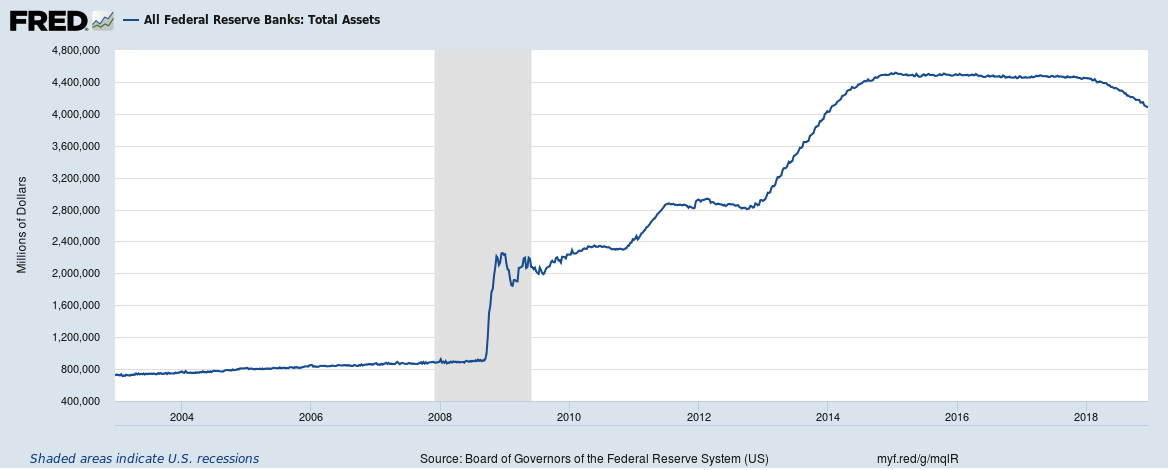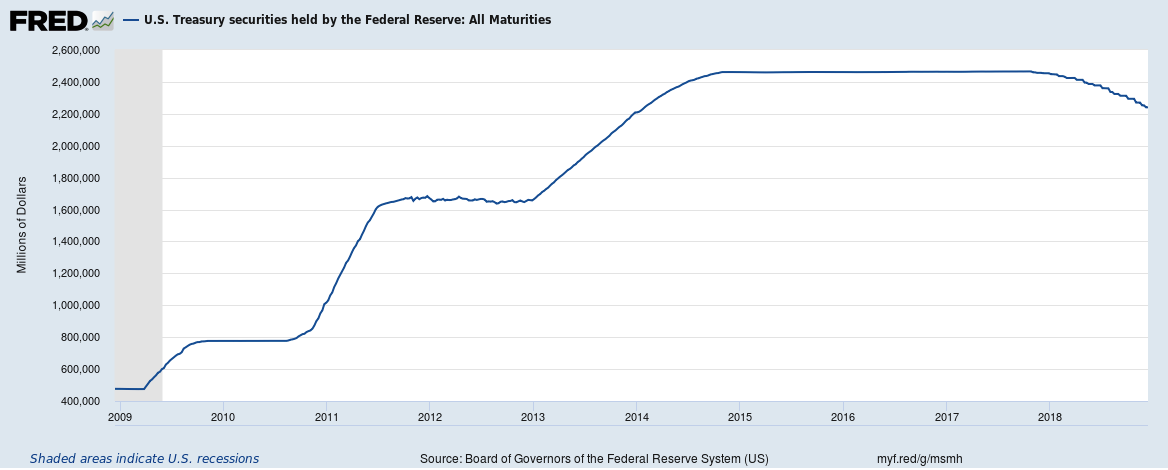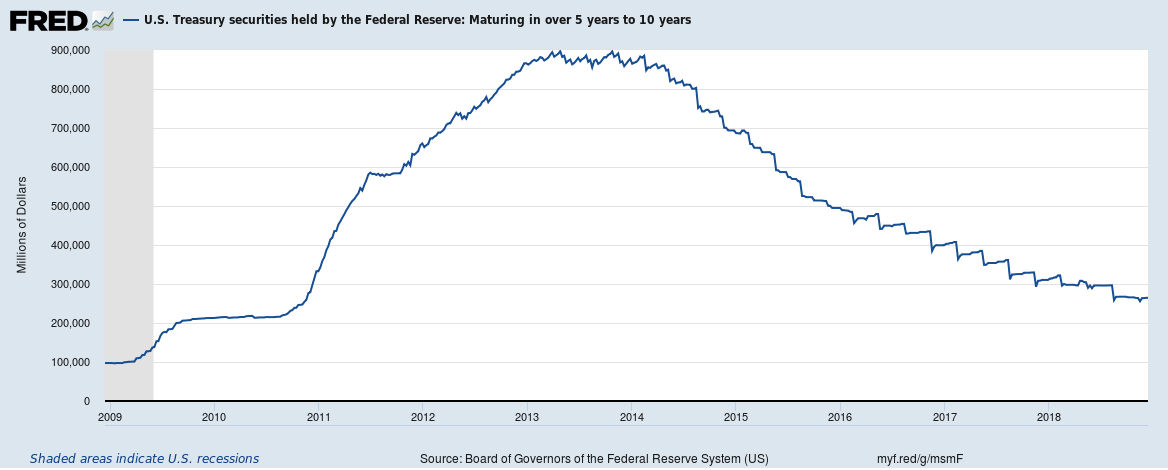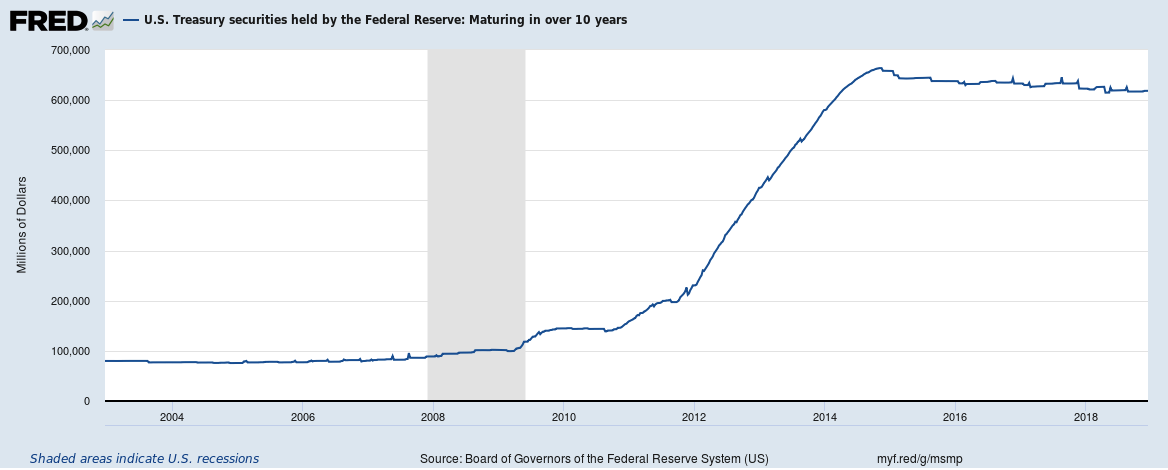2018 Volume Issue 4
Economic Newsletter for the New Millennium
December 18, 2018
For a downloadable version, click the following:
What is going on with the FED?
The FED (FOMC - Federal Open Market Committee) has raised the targeted Federal Funds Rate seven times since December 2016 with more on the way.
The Federal Open Market Committee (FOMC) met on September 26 to decide on whether to raise the Targeted Federal Funds Rate. They did in fact raise the targeted rate for the third time this calendar year to the 2.00% - 2.25% range.
The question now is what will the FOMC do going forward. They will announce/post their latest monetary policy stance on Wednesday, December 19, 2018 after the conclusion of their meeting.
Enacting Monetary Policy at the FED
In a 'normal' environment, the process by which the FED would reach that targeted Federal Funds Rate would be through in the secondary Treasury securities market (buying and selling from bond dealers on the open market). Those open market operations are geared toward altering the 'effective' Federal Funds Rate. In short, the FOMC would direct the NY FED to take the necessary steps to drive up the Fed Funds Rate, as is the current directive.
In selling (or purchasing fewer) Treasury securities (Treasurys) on the open market to select bond dealers this would 'effectively' reduce the supply of Federal Funds, thus influencing the effective Federal Funds Rate. The Fed Funds market is where the depositories borrow and lend funds to meet their reserve requirements to support their loan portfolio. In effect, the FED's aim would be to reduce the overall 'legal' reserves on their balance sheet (see H4.1 https://www.federalreserve.gov/releases/h41/current/).
Policy shift: paying interest on reserve balances
Now that we've walked through the normal process of how the FED implements monetary policy as directed by the FOMC through open market operations at the New York FED, let's go through the current process.
The Financial Services Regulatory Relief Act of 2006 authorized the FED member banks to pay interest on reserve balances.
(https://www.federalreserve.gov/boarddocs/rptcongress/annual06/sec2/c5.htm)
The Regulatory Relief Act gives the Federal Reserve the authority, effective as of October 1, 2011, to pay explicit interest on all types of balances (including required reserves, excess reserves, and contractual clearing balances) held by or for depository institutions at a Reserve Bank. Paying interest on required reserve balances, once authorized, will remove a substantial portion of the incentive for depositories to engage in reserve-avoidance measures, and the resulting improvements in efficiency should eventually be passed through to bank borrowers and depositors."
[This is a departure from previous policies which did not allow those banks to pay interest on those legal reserves, both required and excess reserves.]
Because the Federal Reserve does not pay interest on balances held at Reserve Banks to meet reserve requirements, depositories have an incentive to reduce their reserve balances to a minimum. To do so, they engage in a variety of reserve-avoidance activities, including using "sweep" arrangements that move funds from accounts that are subject to reserve requirements to accounts and money market investments that are not.
In short, the FED now pays the targeted Federal Funds rate on all eligible reserves, including excess reserves. It's important to note that the required reserves total around $139 billion, while the excess reserves are around 12.5 times that amount at $1.7 trillion. Over the last nine months, the total excess reserves have fallen by $426 billion. It's also important to note that the total Bank Credit as recorded in the H.4.1 Factors Affecting Reserve Balances show a $4.1 trillion in Reserve Bank Credit in the October 2018 release. Reflected in that total are $2.2 trillion in U.S. Treasury securities and $1.7 trillion in mortgage backed securities. Twelve months ago, the Reserve Bank Credit was around $330 billion higher, with a reduction in Treasury securities held of around $214 billion and $116 billion in mortgage-backed securities. What does this mean? The FED is in the process of reducing the size of its balance sheet.
Again, the current FED strategy appears to be allowing the bloated balances to runoff or time out, effectively reducing the overall reserves.
Keep in mind that it will take several years for the securities to mature and for this process to run its course - assuming the FED doesn't alter its stance going forward.

Overall Fed Assets = $4.1 trillion

All US Treasury Securities held by Fed = $2.2 trillion

Fed holdings: US Treasury securities maturing 1 - 5 years = $964.8 billion

Fed holdings: US Treasury securities maturing 5 - 10 years = $264.5 billion

Fed holdings: US Treasury securities maturing 10 plus years = $618.6 billion

Fed holdings: MBS (mortgage backed securities) total = $1.7 trillion

Fed holdings: MBS (mortgage backed securities) 10 plus years = $1.6 trillion
Paying Interest on Reserves
As an aside, the FED 'contributes' 95% of the interest it earns on the proceeds from its portfolio of assets held. In 2015, the FED's contribution amounted to $110 billion (See Table 3.2. Federal Government Current Receipts and Expenditures https://apps.bea.gov/iTable/iTable.cfm?reqid=19&step=2#reqid=19&step=2&isuri=1&1921=survey). In 2017, due to the payment of interest on reserve balances, the contribution dropped to $81 billion. Again, there are a variety of explanations for paying interest, but the net effect has been a drop in contributions from the FED to the Treasury, while the overall balance sheet has not shrunk significantly.
Why the move to drive up the Federal Funds interest rate?
So far as the wisdom in driving up interest rates are concerned and the Federal Funds rate in particular, we have to consider what is prompting these actions. The FED's mandate focuses on macroeconomic data and attempts to stabilize the economy in general through its monetary policy: implementing actions to influence interest rates.
Employment or Unemployment
One macroeconomic concern is employment or unemployment. On its face, a very low U3 Unemployment rate of 3.7% would point toward the historical level of "full employment" which is roughly around 4.0%. By moving any lower, this causes concern for the FED in terms of overheating labor markets, causing wage inflation. Since wages constitute in excess of 62% of all income (based on data from the Bureau of Economic Analysis), this is certainly a legitimate cause for concern.
As we have been pointing out for many years in this newsletter, the U3 Unemployment rate can be misleading since it only counts those people who 1) are not employed 2) actively seeking employment. A more accurate measure of the health of the labor markets might be the Labor Force Participation Rate, or LFPR. The LFPR is equal to the Labor Force (Employed plus U3 Unemployed) divided by the Civilian Noninstitutional Population. The Civilian Noninstitutional Population, or CNP, includes those people 16+ years of age who are not counted in the military, incarcerated, or otherwise institutionalized. The CNP of course includes those people who are retired. It's important to note that the baby-boomers are increasingly joining the ranks of those retirees (baby-boom years: born 1946-1-964).
The Labor Force Participation Rate or LFPR came in at 62.7% for September 2018 (Department of Labor, Bureau of Labor Statistics Labor Force Participation Rate https://data.bls.gov/timeseries/LNS11300000). Since the pre-recession level was in the 66 to 67% range, this would suggest that there are large numbers of individuals on the sidelines who are not part of the labor force. Even discounting the fact that significant portion of the baby-boomers (born 1946-1964) have moved into retirement, the current LFPR suggests that there are several million people that could viewed as not being captured by the "official" U3 Unemployment rate.
September 2018 Labor Force Statistics:
- Civilian Labor Force (LF) 162,770,000 (Employed 156,795,000 + Unemployed 5,975) divided by the Civilian Noninstitutional Population (CNP) 258,708,000
- Current LFPR (LF / CNP) = 162,770,000 / 258,708,000 = 62.9%
Adjusting back to a bit higher level of 64% would equate to around 3.2 million added to the labor force (employed + U3 unemployed). Assuming that the aforementioned 6 million individuals were added to the U3 unemployed figure, this would move the U3 Unemployment rate up to 7.1%, far above the 'full employment' unemployment rate.
There are two basic components behind our analysis centering on the Labor Force Participation Rate:
- the baby-boomers are currently remaining in the labor force at historically high levels, in spite of the fact that as a group, they are turning 65 at a rate of around 10,000 per day (https://www.forbes.com/sites/greatspeculations/2018/06/21/social-security-feels-pinch-as-baby-boomers-clock-out-for-good/#7c955c8f4995) "About 10,000 Baby Boomers turn 65 each day. A Baby Boomer is a term that denotes a person who was born between 1946 and 1964. The Baby Boomer represents nearly 20% of the American public."
- the younger age cohorts (16-24 year olds; 25-34 year olds; 35-44 year olds; 45-54 year olds) have not returned to their pre-2008 levels of labor force participation rate levels.
http://econnewsletter.com/2018/aug052018.html
In drilling down on the various age groups (age cohorts), we can see that there is a 3.2 million shortfall in just focusing on the 16 to 54-year-old segment. You would expect in a legitimate economic recovery for the participation rates to return to the pre-recession levels - if not much higher.
All of these factors point to less than robust labor markets, in spite of the 'low' U3 unemployment rate of 3.7%.
Inflation
Another metric employed by the FED in determining monetary policy has to do with price level changes as measured by the Consumer Price Index (CPI) and the Producer Price Index (PPI). The FED has rough target of 2 to 3% for inflation. The current CPI over the preceding 12-month period is at 2.2% registered in November 2018 (reflecting 12-month change from December 2017 through November 2018). The 2.2% is certainly within the FED target level, especially when you consider that the core rate of inflation (leaving out the volatile energy and food) is also at 2.2%.
It has to be made clear that FED monetary policy, in driving up interest rates, acts as a very powerful brake on the economy. In going after inflation in certain areas in the economy, such as the cost push variety stemming from rising wages (labor) or rising fuel costs, restrictive monetary policy slows down the entire economy, not just the energy sector.
Another aspect of this conversation has to do with the FED's position that the 'neutral' Fed Funds rate should be in the 3-4% range. We hear that interest rates are at historic lows and those rates have to go up'but why?
Economic growth
In looking at the final leg in the FED macroeconomic mandate, we have economic growth, e.g., GDP (Gross Domestic Product). Bearing in mind that the last time that the U.S. experienced 3.0% annual Real GDP growth was in 2005 when it registered 3.5% for the year. Given that fact, one could argue that on the basis of that alone, the FED would allow the economy some time and latitude to return to its pre-recession trajectory. In order to accomplish that, it would require three full years of 5% annual Real GDP growth.
Wrapping - up
The takeaway from this newsletter article is to gain an understanding of the FED's actions and the potential pitfalls that may result. In looking at previous FED restrictive monetary policy actions we can go back to a couple of recent examples.
The Savings and Loan Crisis: The Genesis of the Adjustable Rate Mortgage
The Savings and Loan Crisis developed in the 1980s and into the 1990s when roughly a third of the savings and loan institutions failed - think George Bailey from It's a Wonderful Life and his Building and Loan. With rampant inflation in the late 1970s and into the 1980s, the mortgage lenders were caught flat-footed with fixed rate mortgages. It's not difficult to see how their inability to respond more quickly spelled doom for them. By the time that legislative action caught up to the crisis, we already ran into massive failures and political fallout with the so-called Keating Five. It basically boiled down to the fact that the financial intermediaries, i.e., the savings and loans, were unable to offset the problems with their fixed rate loan portfolios due to legislative restrictions. Meanwhile, the FED had embarked on its 'tardy' response to the inflationary pressures form the energy crises and increased government spending ways going back to LBJ's Great Society (War on Poverty, Racism, and in Vietnam).
With this backdrop, it is understandable that the corporate mentality of the FED centered on holding inflation at bay and preventing it from coursing through the economy - any hint of inflation had to be addressed, regardless of its source. Chairman Volcker's FED was successful in squeezing out inflation in the 1980s, by driving up interest rates, and there was a general consensus at the FED that they would never be so late in responding with restrictive monetary policy actions.
The FED's Conundrum: Run up to the Great Recession
Beginning in 2004, the FED drove up the Federal Funds rate from 1.0% in June to 5.25% in June 2006. This interest hike regime was promoted by the FED to address the wealth effect, a counter to appreciating asset prices. Chairman Greenspan expressed his exasperation at the so-called conundrum, where short-term rising interest rates, driven by FED monetary policy, were blunted and ineffectual in the longer term, resulting in a flattening yield curve.
At this same time, the issues associated with adjustable rate mortgages and teaser rates were appearing. Owing in part to the FED's obsession with inflation, going back to its experiences in the 1970s in efforts to contend with pressures emanating from the spikes in energy prices, its accommodative stance contributed to double digit inflation rates approaching 20% annually, on a monthly basis. In driving up short-term rates, this caused adjustable rate mortgages to adjust upward. A series of poor policy decisions proved disastrous. The FED, in its restrictive monetary policy and Congress through the passage of legislative actions such as the Community Reinvestment Act (CRA) https://en.wikipedia.org/wiki/Community_Reinvestment_Act, which forced lenders to make subprime loans (think teaser rates, where rates automatically jumped significantly, regardless of any adjustments associated with inflation margins) to borrowers that probably should been renting, all pointed to disastrous outcomes. In addition, rescinding the Glass Steagall Act, which erected a "Chinese Wall' of sorts between commercial banks (risk averse) and investment banking (Wall Street brokers) interests. This Depression era legislation was undone by the Gramm Rudman Act, signed into law by President Clinton, in 1999.
Final thoughts
What all of this really boils down to is whether the FED's implementation of target Fed Fund rate hikes is warranted or not. Be sure to keep in mind that with the current policy of paying interest on reserves, the target and effective rate are essentially the same. The latest instability in the stock market in particular might suggest that the FED is overreacting, but that corporate mentality associated with addressing even a hint of inflation remains very strong in the institution. To restate the obvious, the FED has enormous power in slowing down the economy for consumers and business alike by driving up the targeted Fed Funds rate. Given the moderate rate of inflation, degree of hidden unemployment (discouraged workers) as highlighted by the low labor force participation rate, and the dismal economic growth over the last 13 years, it only makes sense that the FED should consider easing off. Unfortunately, we have to endure the side effects of these policies as they manifest themselves in such things as stock market gyrations, etc.


